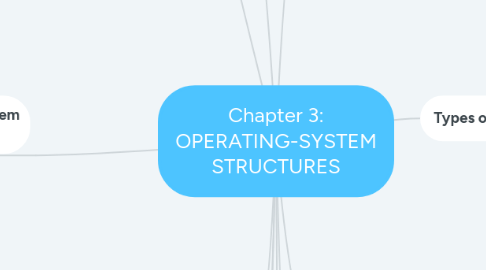
1. Operating System Services
1.1. User interface
1.1.1. Almost all operating systems have a user interface (UI)
1.2. Program execution
1.2.1. Load a program into memory and to run that program, end execution
1.3. I/O operations
1.3.1. The user programs cannot execute I/O operations directly, the os must provide some means to perform I/O.
1.4. File-system manipulation
1.4.1. Program capabilities
1.4.1.1. read files
1.4.1.2. write files
1.4.1.3. directories
1.4.1.4. create
1.4.1.5. delete
1.4.1.6. search
1.4.1.7. list file Information,
1.5. Communications
1.5.1. Processes may exchange information, on the same computer or between computers over a network
1.6. Error detection
1.6.1. Ensure correct computing by detecting errors in the CPU and memory hardware, in I/O devices, or in user programs.
2. Additional Operating System Functions
2.1. Resource allocation
2.1.1. allocating resources to multiple users or multiple jobs running at the same time.
2.2. Accounting
2.2.1. keep track of and record which users use how much and what kinds of computer resources for account
2.3. Protection and security
2.3.1. The owners of information stored in a multiuser or networked computer system may want to control use of that information, concurrent processes.
3. System Calls
3.1. Provide the interface between a running program and the operating system.
4. Communication Models
4.1. message passing
4.2. shared memory
5. Microkernel
5.1. -Small os core
5.2. Many services traditionally included in the operating system are now external subsystems
5.2.1. Device drivers
5.2.2. File systems
5.2.3. Virtual memory manager
5.2.4. Windowing system
5.2.5. Security services
5.3. -Contains only essential core operating systems functions
6. Operating System Design
6.1. -Design and Implementation of OS not “solvable”, but some approaches have proven successful. -The design of the system will be affected by the choice of hardware and the type of system: batch, time shared, single user, multiuser, distributed, real time or general purpose.
7. Common System Components
7.1. Process Management
7.2. Main Memory Management
7.3. File Management
7.4. I/O System Management
7.5. Secondary Storage Management
7.6. Networking
7.7. Protection System
7.8. Command-Interpreter System
8. Types of System Calls
8.1. Process control
8.2. File management
8.3. Device management
8.4. Information maintenance
8.5. Communications
8.6. Protection
9. Layered Approach
9.1. Advantage
9.1.1. Simplicity of construction and debugging
9.2. Disadvantages
9.2.1. The careful definition and interaction of the layers
9.2.2. Less efficient
10. Benefits of a Microkernel Organization
10.1. Extensibility
10.1.1. Allows the addition of new services
10.2. Flexibility
10.2.1. New features added
10.3. Reliability
10.3.1. Modular design
10.4. Portability
10.4.1. Changes needed to port the system to a

